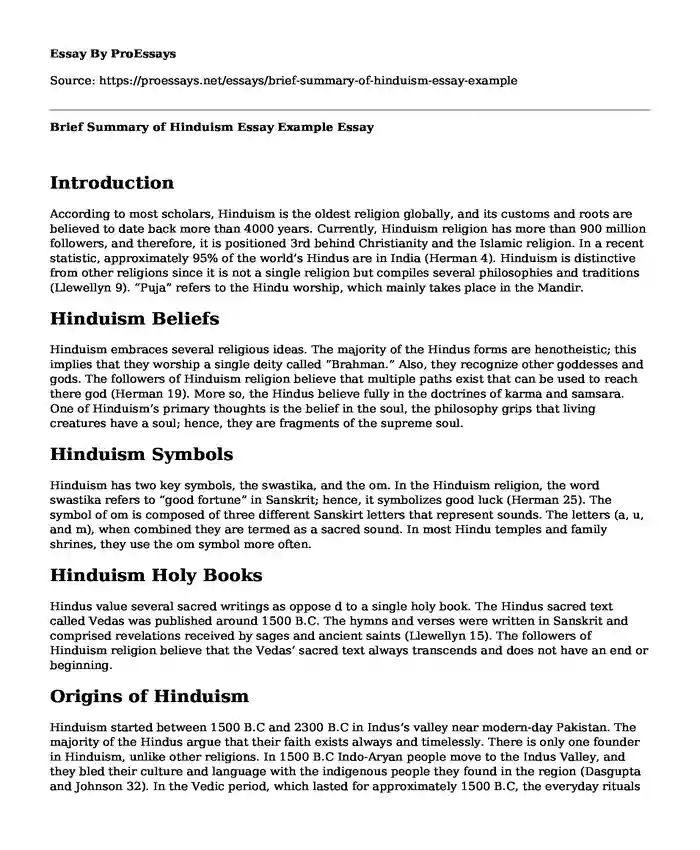Introduction
According to most scholars, Hinduism is the oldest religion globally, and its customs and roots are believed to date back more than 4000 years. Currently, Hinduism religion has more than 900 million followers, and therefore, it is positioned 3rd behind Christianity and the Islamic religion. In a recent statistic, approximately 95% of the world’s Hindus are in India (Herman 4). Hinduism is distinctive from other religions since it is not a single religion but compiles several philosophies and traditions (Llewellyn 9). “Puja” refers to the Hindu worship, which mainly takes place in the Mandir.
Hinduism Beliefs
Hinduism embraces several religious ideas. The majority of the Hindus forms are henotheistic; this implies that they worship a single deity called “Brahman.” Also, they recognize other goddesses and gods. The followers of Hinduism religion believe that multiple paths exist that can be used to reach there god (Herman 19). More so, the Hindus believe fully in the doctrines of karma and samsara. One of Hinduism’s primary thoughts is the belief in the soul, the philosophy grips that living creatures have a soul; hence, they are fragments of the supreme soul.
Hinduism Symbols
Hinduism has two key symbols, the swastika, and the om. In the Hinduism religion, the word swastika refers to “good fortune” in Sanskrit; hence, it symbolizes good luck (Herman 25). The symbol of om is composed of three different Sanskirt letters that represent sounds. The letters (a, u, and m), when combined they are termed as a sacred sound. In most Hindu temples and family shrines, they use the om symbol more often.
Hinduism Holy Books
Hindus value several sacred writings as oppose d to a single holy book. The Hindus sacred text called Vedas was published around 1500 B.C. The hymns and verses were written in Sanskrit and comprised revelations received by sages and ancient saints (Llewellyn 15). The followers of Hinduism religion believe that the Vedas’ sacred text always transcends and does not have an end or beginning.
Origins of Hinduism
Hinduism started between 1500 B.C and 2300 B.C in Indus’s valley near modern-day Pakistan. The majority of the Hindus argue that their faith exists always and timelessly. There is only one founder in Hinduism, unlike other religions. In 1500 B.C Indo-Aryan people move to the Indus Valley, and they bled their culture and language with the indigenous people they found in the region (Dasgupta and Johnson 32). In the Vedic period, which lasted for approximately 1500 B.C, the everyday rituals include chanting and sacrifices. In the Hinduism religion, The Puranic, Epic, and Classic periods occur between 500 B.C and 500 A.D. In that period, Hindus commence emphasizing the worship deities. Other faith, such as Jainism and Buddhism, spread rapidly when the concept of dharma was presented in new texts. The medieval era of Hinduism lasted from approximately 500-1500 A.D before new texts were introduced, and poet-saints documented their spiritual sentiments during this period.
Works Cited
Llewellyn, John E. Defining Hinduism: A Reader. Routledge, 2017.Dasgupta, S. D., and A. J. Johnson. “Hinduism in Brief.” Religion and Men’s Violence Against Women (2015): 371.
Herman, Arthur L. Brief introductions to Hinduism: Religion, philosophy, and ways of liberation. Routledge, 2018.
Cite this page
Brief Summary of Hinduism Essay Example. (2024, Jan 05). Retrieved from https://proessays.net/essays/brief-summary-of-hinduism-essay-example
If you are the original author of this essay and no longer wish to have it published on the ProEssays website, please click below to request its removal:
- Unity, Relativity and Exclusivity in Christianity
- Inductive Paper on the Bible and Literature
- Paper Example on Servant Leadership
- Christian View on Treatment of Mental Illness - Essay Sample
- Essay Example on Religion and Sport: Christianity's Influence on Modern Sports Culture
- Essay Sample on The Resurrection of Christ: Beliefs, Transformations, and Narratives
- Free Essay Sample on Day of the Lord: Catastrophe, Calamities, and Contest







